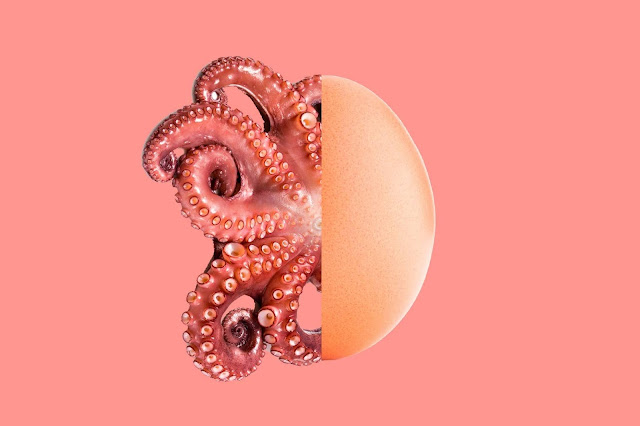This is the egg-laying season if you're a bird.
If you're an octopus, particularly a giant Pacific
octopus, you've been there, done that. In fact, you died doing it, in what is
the saddest mommy story I've heard in a long while. It calls, "No
Mother Could Give More."
We begin with a pregnant octopus. She's been that way
for four or five months, carrying the eggs inside her body until one day, in
mid-winter, when the water temperature is right, she starts expelling her eggs,
one by one, into the water. She will produce (and this will take her a month or
so) about 56,000 individuals, who float free until she gathers them into
groups, then stitch them into hanging braids, like a bead curtain in a
Chinese restaurant.
This is her octopus "den" (a wild
mammal's hidden home or a lair). It's usually an underwater cave, protected by
rocks that she's put at the entrance to keep hungry crabs, sea stars, and fish
from getting too close. She's glued about 170 braids to the roof and there she
sits, often right under the babies. "Each egg," is a gleaming white
tear-drop about the size of a grain of rice. Months pass. All this time, the
mother is constantly on guard.
(The hidden place to keep the egg keep safe without eating)
The mother spends five, six months protecting her
56,000 children. She constantly waves her arms gently over the plaits of eggs,
making sure that nothing harmful settles on them. With her siphon, she blows
water gently over them to keep them aerated. She uses her arms to keep
potential predators away from the eggs, and as far away from the den as
possible she normally does not leave the den at any time.
Throughout this whole period of more than half a year,
she never eats. All of the energy in her body is slowly consumed by her work
until, by the time the offspring emerge, she has nearly starved to death. Then
one night, though she is weaker and smaller. Her once the brick-red color is now a
deathly gray and her skin shows signs of decay, her breath now coming in
"sporadic gasps,"( a short quick
breath of air that you take in through your mouth) she repositions herself and
blows all of her babies out of the den into the open water.
It's essential that she uses her siphon to blow them
free, and once they detach, the babies know exactly what to do. The babies are
spectacular. Measuring 6 mm and weighing just 0.029 grams, they are perfect
miniatures of their parents. They have 8 tiny arms adorned with suckers. They
can change colors instantly and can even produce a miniature puff of ink when
they are disturbed.
But the mom is near exhaustion.
She hasn't eaten for
so long probably because food could attract predators, or because debris from
eating could bring parasites near the eggs, she keeps gently blowing water over
the babies, pushing them from the den for as long as she can until she herself
floats free and sometimes, only two or three meters from the den opening, she
stops breathing and dies. Her babies? They go straight to the ocean surface,
feed there, grow; some will descend deeper into the ocean where they will dodge
jellyfish, sharks, and blue whales and hope to survive.




Comments
Post a Comment